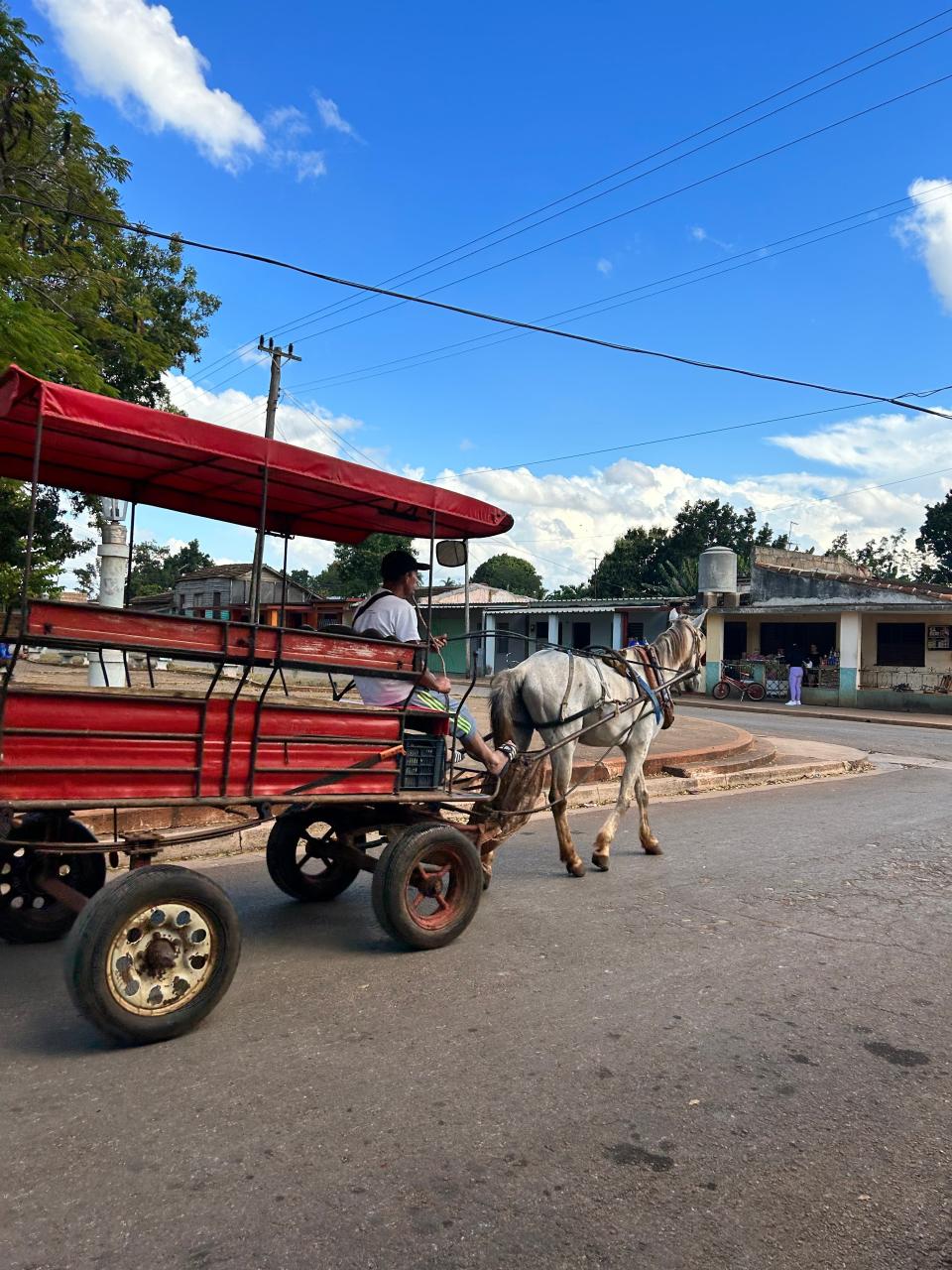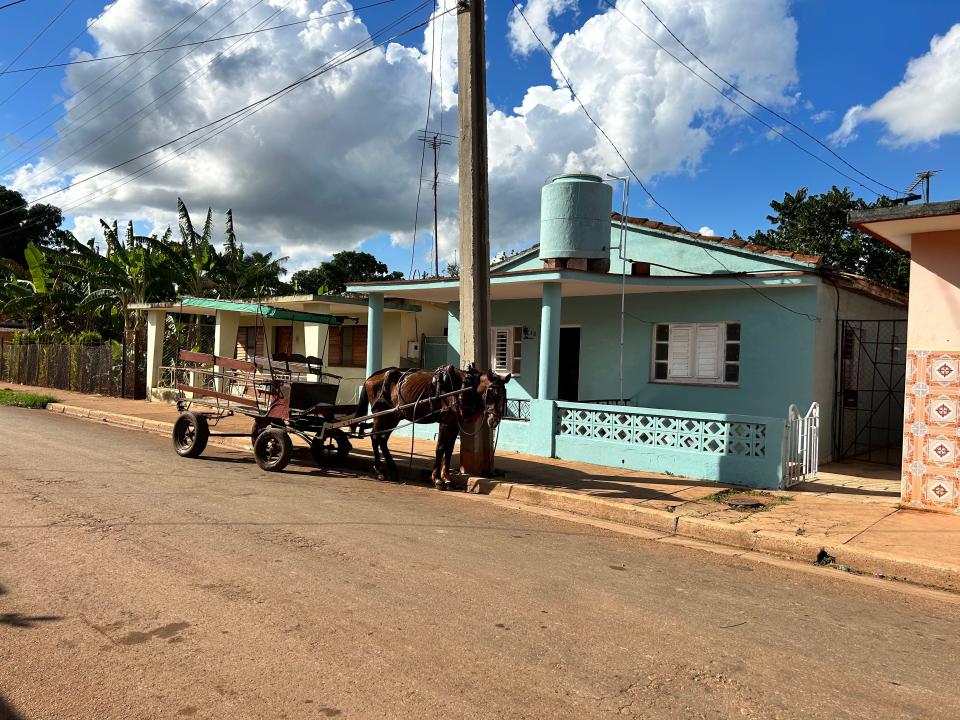People are fleeing Cuba’s economic collapse. Here’s what life is like for those left behind.
MANGUITO, CUBA – The majority of Marcos Perez’s friends fled the country last year. Now, he and his family are pooling their money to do the same.
“Only a few of my friends are left, the ones who lack ambition and the ones who have kids. I could count them on one hand,” Perez said. His father sells goods on the black market to keep the family fed and clothed, and has even earned enough to buy a new, sleek metal fridge, an uncommon luxury in Cuba.
Over the past year, 305,000 Cubans crossed the U.S.-Mexico border, most asking for asylum. That’s nearly 3% of the island’s population. Many migrants flew to Nicaragua or Panama, countries that do not require a specific visa for Cubans, and trekked through Central America and Mexico to arrive at the U.S. border. Others applied for visas to travel to the U.S. directly. The exodus was the product of the island’s economic collapse, which has driven many thousands into food insecurity.
Originally, Cubans were exempt from Title 42, the pandemic-era law that allowed border patrol to return migrants from six countries into Mexico without a formal deportation process, due to public health concerns. Then, in January, President Joe Biden signed an executive order effectively ending this exemption and blocking Cubans from entering the United States through the Mexican border and asking for asylum.
Since then, thousands of Cubans have been turned away and are now stuck in border towns in Mexico. Title 42 recently expired, but the alternative is not much better for Cuban migrants. A new order from the administration equires migrants to apply for asylum in Mexico before they arrive at the U.S. border, and most single adults will be turned away and deported back into Mexico if border patrol encounters them at the wall. Mexico has agreed to keep taking in migrants from other countries, as they did under Title 42, in exchange for the building of a gas pipeline and other infrastructural projects.
Thousands who were planning to leave Cuba through the U.S.-Mexico border route are frantically looking for sponsors within the U.S. who can help them get a visa through the new humanitarian parole program, which requires Cubans to apply for a visa, wait for months for an approval, and then fly directly from Havana. Those who cannot find a sponsor, a U.S. citizen or permanent resident who can legally vouch for the migrant, are left without options.
At the same time, Cuba is facing an economic disaster, along with bleak shortages of food and fuel. Hundreds of thousands of people who were planning to leave the island this year will not be able to, as only those with strong ties to the U.S., in the form of a family member to serve as a sponsor, will be allowed in.
Critics of Biden’s new immigration policy say it is inhumane, as it forbids Cubans, many of whom are facing severe poverty and food insecurity, from asking for asylum, and abandons migrants in Mexican border towns where they are vulnerable to kidnappings for ransom.
“It’s a rich and middle class migrant program, because you need both a passport and a sponsor. It’s gatekeeping. It isn’t a humanitarian law because it favors migrants with more access," said Adam Isacson, the Director of Defense Oversight at the Washington Office on Latin America.
A drop in Cuban migration to the U.S.
Cuban migration to the U.S. has dropped by nearly 90% since the introduction of the new policy, but Cubans are still the third-most represented country of origin for migrants crossing the Guatemala-Mexico border, meaning thousands of Cubans are stuck waiting in Mexico for the rules to change.
To make things worse, the poverty inherent in modern Cuban life is in part the result of the long held U.S. embargo, which forbids any company, U.S. or foreign, from operating both in the United States and Cuba. This rule effectively isolates Cuba from the rest of the global economy. President Barack Obama, in 2015, announced a reopening of diplomatic relations and tourism with Cuba and it looked as if the embargo was on its way out. However, under President Trump, sanctions on Cuba were augmented, leading to a severe oil shortage, and Americans were again forbidden from visiting the island as tourists. Under President Biden, Cuba policy has more closely resembled Trump’s approach, with perhaps a more neutral attitude. In 2021, the Biden administration said, in a press conference, that a change in policy towards Cuba was “not a priority”.
During the pandemic, Cuba’s economy nosedived, and it seems no matter how much society returns to “normal”, the value of the Cuban peso slides further and further downward and prices for most necessary goods spike ever higher into a canopy of unaffordability. Some believe this collapse is worse than that so-called “Special Period” in the 90’s, when many Cubans faced serious food insecurity.
Over the past four years, the customary price of a ham sandwich from a street vendor in Havana has risen by 2000%. Rolling blackouts are common in rural areas, and the value of the Cuban peso in street exchanges has dropped from 25 pesos to the dollar (in 2019) to nearly 200 pesos to the dollar. The price of a packet of pork, enough to feed two people for about a week, costs the same as the average monthly salary in Cuba, which is close to fifteen dollars at the current street exchange rate.
Now, with the new immigration policy, those left behind in Cuba have few options to leave themselves, and must stay and endure whatever will happen next.
An altered economy, a quiet town park, and horse carts for transport

The absence of hundreds of thousands of people, many of them in their 20’s and 30’s, has left holes in many industries, and altered Cuba’s economy. In Perez’s pueblo, Manguito, Matanzas, 120 miles away from Havana, nearly half the population of 2,000 disappeared over one calendar year, fundamentally altering the fabric of the community.
It’s three in the afternoon and Manguito’s central park, a collection of trees, metal benches, and a few patches of grass, sits still in the sun. Iliana Herrera, a retired historian who lives in the village, recognizes this silence as the new normal. The teenagers who used to chatter in the square are gone now. Only a few remain, wandering back and forth in their school uniforms, trying to catch cell service on their phones.
“It used to be that you’d open your door, and even though the town is tiny, there was a vibrant social life on the street— you’d see young people playing sports, listening to music, chatting about this and that. The emptiness is noticeable,” Herrera said.
Without oil, many people say finding transportation on the island is akin to “doing magic”. Chauffeurs wait in lines for days to fill their taxis with gasoline, and buses often arrive two or three hours late, overstuffed to the point that everyone inside becomes one, sweaty body. In the early 20th century, Manguito was home to one of Latin America’s first railroad stations. Now, people use horse carts for transport.
Julio Gomez, a schoolteacher who has taught Manguito’s adolescents for decades, has noticed a significant shift in the temperament and interests of his students. The pull of escape is so strong, teenagers no longer appear interested in building lives in Cuba. There is no hunger for learning, only for leaving. Their focuses are the accumulation of cash needed to leave the country and distracting themselves to pass the days while they wait their turn to board an airplane.

Only mayonnaise for sale
The internet offers a lesson that much of the world is free of the scarcity that plagues the island. Manguito’s one state-run store is a white box with mostly empty shelves. Often, there’s an influx of one product, like mayonnaise or detergent, and nothing else for sale. Products must be bought using special cards that can only be filled with dollars or euros, as the Cuban government needs convertible currency.
Each Cuban citizen receives a small cache of rice, beans, hot dogs, soap, and other basic items from the government, but it is nowhere near enough to survive. Most people sell goods on the black market, which means selling items out of their homes, to afford to live.
Now, with the majority of the working population gone, Manguito has stagnated even further. The retirees who make up the largest segment of the village are not working the land or raising pigs, Manguito’s previous industries. They are living off of black-market deals, government rations, and a slow trickle of cash from relatives abroad, as their monthly pensions edge closer to ten dollars a month.
“Undoubtedly emigration affects the economic development of the population, when the majority of the labor force is leaving due to the conditions and the material limitations of life here. The majority of the people who leave are of working age, and so the standard of life for everyone descends considerably,” Herrera said. “It is impossible to start development in a place without the necessary raw materials, and now with no food, and with no people.”
To make things worse, the town will be forced to wait months or years for remittances to arrive from those who left recently. Customarily, relatives abroad will foot the 10,000 dollar bill for the journey to the U.S., because it is virtually impossible to save that much money while living in Cuba. After settling in, in Miami, or Houston, or the New Jersey suburbs, the migrant is often expected to pay back that 10,000 dollars as fast as they can by working multiple grueling jobs. Only when they have paid their debts and figured out how to support themselves can anything be sent back to Cuba.
Sometimes, remittances don’t just arrive late– they never arrive at all. Several young people from the village ostensibly made it to the United States and then disappeared, never contacting their families back in Cuba or responding to messages from anyone on the island. “Sometimes a son will leave and then forget his family. We as a town try to offer solidarity to the families when this happens and help them survive,” Herrera said.
LuzMaria Hernández, who lives in Manguito and has two adult sons in the U.S., is struggling to feed herself. Every six months, her eldest son returns to Cuba and buys her a stockpile of supplies, and she sells cigarettes and other items out of her home while she awaits his return. But Hernández’s younger son never figured out how to support himself in Miami. Shortly after his arrival in Florida, he was busted selling marijuana in an attempt to pay back his debts, and is now in prison. Hernández disappears into the back room of her house and returns with a creased photo of her sons from over a decade ago, holding beer cans and smiling, back when Manguito had rowdier neighborhood parties. “Doesn’t he look happy?” she says, of her younger son. “They were so close.”
Back at the Perez house, the mood is light, and a meal of rice, beans, and pork is bubbling on the stove. Adida Perez, Marcos and Mardelys’ mother, says she is not sure how they will save up enough money to leave the country, only that this is the plan, so for now, there’s nothing left to do but continue buying and selling, wait and see.
“Can you find us a sponsor?” Adida Perez asks.
This article originally appeared on USA TODAY: What is life like for people still in Cuba?

